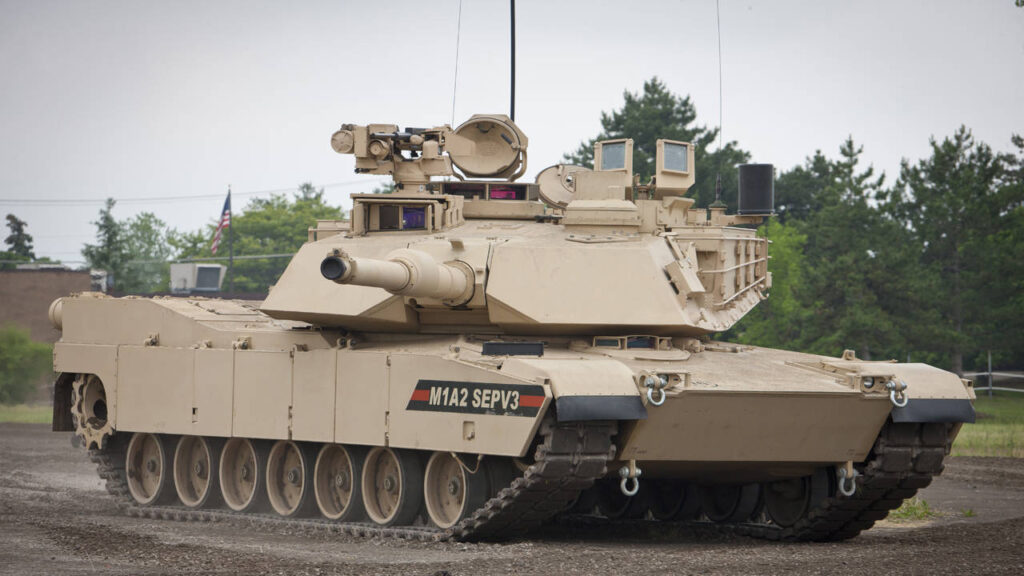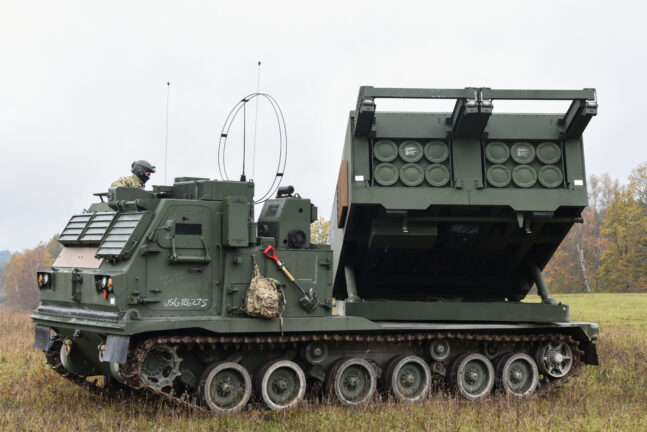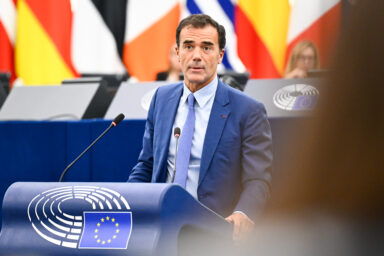The EU’s vague promise to increase weapon purchases in the United States as part of the recent tariff deal seems to be nothing more than a rhetorical win for President Trump. The European Union has no control over such investments, which would potentially come exclusively from the private sector. Political leaders and chief economists rather recommend to develop Europe’s own military capabilities.
The smiles were ear-to-ear when US President Donald Trump and Commission President Ursula von der Leyen on Sunday, 27 July announced in Scotland a trade deal stipulating that most EU goods exported to the United States will be subject to a 15 per cent tariff. In his speech, Mr Trump said that the EU would boost its investment in the US by $600bn, including military equipment.
Similar wording appeared a day later in the official White House press release stating that “the European Union agreed to purchase significant amounts of U.S. military equipment by 2028”. On the very same day, however, the EU has admitted it doesn’t have the power to deliver on such a promise. “It is not something that the EU as a public authority can guarantee. It is something which is based on the intentions of private companies,” said one of the senior Commission officials cited by different media outlets.
Dependency, to a certain extent
Analysts seem to be split in views whether the EU’s military spending promise is technically possible and what the political background could be. One thing, however, remains clear: Europe is – and in the foreseeable future will be – dependent on the United States when it comes to selected military equipment.
“It is not all unrealistic for the EU countries collectively, to spend some $100bn on US defence equipment. – Tim Lawrenson, European defence analyst
The increase of EU’s military spending in the US will, however, will be probably much lower than Mr Trump envisaged. “New commitments (to purchase US arms), no doubt, are going to happen (…) It is not all unrealistic for the EU countries collectively, to spend some $100bn on US defence equipment,” Tim Lawrenson, a European defence analyst, told Breaking Defense.
A recent analysis shows that Europe’s militaries still much rely on US-made weapons and equipment. especially in some sectors. About 46% of the fighter jets used by European air forces originate from the US. In the case of missile systems the share is 42%. And though EU member states are now keen to expand its own military production and facilities – also because of the recent NATO spending target of 5 percent of GDP on defence – it is going to be a long haul. The Europe’s industrial capacity is simply limited.
You might be interested

“Even if there’s a substantial investment in increasing capacity in European countries, it is not going to be enough to meet the demand. Plus there there are some products that the EU does not have anyway, so it is bound to go to the US,” added Mr Lawrenson.
Draghi: Produce arms domestically
According to European Council’s statistics, in 2024 EU member states collectively spent €326bn on defence. Compared to the 2020 figure (€198bn) it makes a 65% rise. Which portion of that sum accounts for military imports from the US is not exactly clear; estimates range around 50%.
Given the deteriorating international situation including fractured relations with the United States, voices calling for increased defence spending in Europe are stronger than ever. Bringing spending home to boost defence is one of 10 key proposals made by Mario Draghi, ex-president of the European Central Bank, in his famous report The future of European competitiveness (dubbed “the Draghi report”, released in September 2024).
Some US defence products are not always suitable for European needs and will be even less so in the future, as the US adjusts its military capabilities to react to new threats in the Pacific. – The future of European competitiveness (“Draghi Report”)
When it comes to defence, Mr Draghi suggests a swift departure from the ‘buy in the US’ concept labelling it “legacy of World War II and the Cold War”. In his higly praised and often cited report, he sharply critisizes EU’s dependency on non-EU defence solutions, especially from the United States. “The choice to procure from the US may be justified in some cases only because the EU does not have some
products in its catalogue (…) However, in many other cases a European equivalent exists, or could be rapidly made,” the report says.
Mr Draghi also warned that the changing geopolitical dynamics affects the nature of the US military production. “Some US defence products are not always suitable for European needs and will be even less so in the future, as the US adjusts its military capabilities to react to new threats in the Pacific,” Mario Draghi wrote.
The choice to procure from the US may be justified in some cases only because the EU does not have some products in its catalogue. – The future of European competitiveness (“Draghi Report”)
Draghi’s recommendations are clear: the EU must expand and develop its defence industrial and technological base so that it can meet new European defence and security needs.
SAFE prioritizes European companies
The Security Action for Europe (SAFE) instrument, adopted by the European Council in May 2025, is another exmple of an action that goes directly against EU countries’ defence spending in the United States and elsewhere. SAFE will provide loans worth up to €150bn and is intended to support those member states that wish to invest in defence industrial production through common procurement.
The instrument, however, severly limits involvement of third countries including the United States. Apart from EU member states, only selected third countries are allowed to join common procurements: EEA and EFTA countries, EU candidate countries, Ukraine, and countries that have signed a Security and Defence Partnerships with the EU. The latter includes the United Kingdom or Japan, but not the US.
Though the terms of SAFE still allow some involvment of third countries, the cost of the components originating outside the EU, EEA-EFTA states, and Ukraine must not be higher than 35 per cent. In other words, purcheses of U.S. arms are not totally excluded within the SAFE scheme – but could account just for a relatively small portion of the whole thing.










